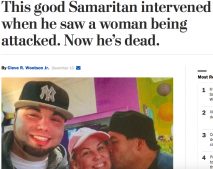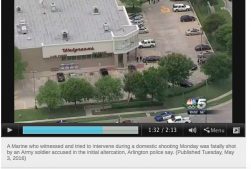 It doesn’t take much time to find examples of tragedy involving would-be heroes. You can also find plenty of stories about people who acted heroically and were successful with details that reveal how close tragedy was. The point of this article isn’t to diminish the likelihood of you helping someone when you can, it is to maximize your likelihood of success while minimizing the risk you expose yourself to.
It doesn’t take much time to find examples of tragedy involving would-be heroes. You can also find plenty of stories about people who acted heroically and were successful with details that reveal how close tragedy was. The point of this article isn’t to diminish the likelihood of you helping someone when you can, it is to maximize your likelihood of success while minimizing the risk you expose yourself to. The decision of whether or not to act in defense of others is one that you should serious contemplate, especially if you go armed in the public space and have trained to use your gun defensively. In the heat of the moment, complicated decision making or even accurately processing the information your senses are collection can’t be counted on. But, if you have a simple checklist to go down, your odds of making a good decision can go up dramatically. Commit these three questions to memory, so that you might come up with answers quickly in the event that you think you see someone being victimized and are compelled to get involved:
1. Do you really know what is going on?
2. Are you confident your involvement will make things better?
3. What is the least you can do?
By answering these three questions, your chances of making things worse will go do down significantly. Let’s look at each item on the Good Samaritan Checklist:
1. Do you really know what is going on?

In this situation, a well meaning witness got himself killed in front of his family by interjecting AFTER the initial violence had ended.
2. Are you confident your involvement will make things better?
This question needs to be answered in two ways: First, if someone is being verbally assaulted and you interject, what are you really hoping to do? If you escalate things, will you make them worse. Keep in mind that making yourself a victim, even if you do help the other person, may very well make things worse for you and your family in the long run. It is all well and good to be willing to sacrifice for the greater good, but will your family and those who depend on you agree with, much less be made better by, your decision? It is one thing to get injured or arrested fighting evil when that evil attacked you directly, it is a very different price to pay when you interject yourself into a situation.
 The second way you need to answer this question is in terms of your actual capabilities to make things better. If you are attacked in a way that overwhelms your preparations, you still need to do something. But, if you are witnessing a situation that is beyond your ability to confidently intervene, you are simply being reckless to get involved. An example might be wading into a situation where a crowd is physically attacking one person. If you were attacked by a group of people, doing your best to protect yourself, possibly disable one or more of them and attempting to get away are of the necessity. If you wade impulsively into a crowd that you know you cannot take on entirely by yourself and simply hoping things work out, you would be judged reckless by most people who take self-defense seriously. Keep in mind that it is much harder to protect someone else and yourself at the same time.
The second way you need to answer this question is in terms of your actual capabilities to make things better. If you are attacked in a way that overwhelms your preparations, you still need to do something. But, if you are witnessing a situation that is beyond your ability to confidently intervene, you are simply being reckless to get involved. An example might be wading into a situation where a crowd is physically attacking one person. If you were attacked by a group of people, doing your best to protect yourself, possibly disable one or more of them and attempting to get away are of the necessity. If you wade impulsively into a crowd that you know you cannot take on entirely by yourself and simply hoping things work out, you would be judged reckless by most people who take self-defense seriously. Keep in mind that it is much harder to protect someone else and yourself at the same time.3. What is the least you can do?
That line from Edmund Burke is often referenced during these discussions, so let’s make sure we get it in here:
“The only thing necessary for the triumph of evil is for good men to do nothing.”
I agree… but, I know that there are often many ways to get involved beyond doing “nothing”. It may take a second or two to process your options, but after you’ve determined that you do know what is going on and that you can make things better, it is worth taking a moment to figure out the best way to intervene. Unlike at attack directly on you, when you decide to intervene you have the initiative. You have the opportunity to expose yourself, and everyone else around you, to as little additional risk as possible. Perhaps maintaining distance, possibly even staying hidden, contacting the police and simply calling out to the attacker to stop and letting them know they have been seen are enough. Perhaps threatening to get more involved without actually making contact is enough. Perhaps you can find an improvised tool to use instead of getting involved with bare hands, if that is your only other options.
 Sometimes, the old adage about “being a good witness” is vita, especially when you are witnessing a property crime, including something like someone stealing a car or engaged in other serious crime. Remember, there is a big difference between being a Good Samaritan and being a Vigilante… but, in the heat of the moment, the line can get blurred very quickly.
Sometimes, the old adage about “being a good witness” is vita, especially when you are witnessing a property crime, including something like someone stealing a car or engaged in other serious crime. Remember, there is a big difference between being a Good Samaritan and being a Vigilante… but, in the heat of the moment, the line can get blurred very quickly. Commit the Good Samaritan Checklist to memory as part of your training. One great way to get started is to share these concepts with others and discuss them… perhaps they will have some interesting points of view that help you understand your own inclinations better, especially if you talk to people who care about you and would be affected by the ramifications of your interactions.
-RJP

Excellent and comprehensive. Key point; if you don't know FOR SURE that the person you intend to "defend" is NOT originally, or later, the AGGRESSOR, call 911, then record what you can from a safe distance.
Using lethal force to stop a shoplifter is illegal in most states. One of the basic questions you must ask yourself before using lethal force is, "Is someone in danger of severe injury or death", or in states lucky enough to have the Castle Doctrine is law, "Am I protecting my Castle"? I don't think shoplifting fits ether of those criteria. --- Also, why would anybody endanger their lives to protect Home Depot merchandise? It's only merchandise. I believe that Home Depot tells their employees not to intervene with shoplifters. I've read that employees have been fired for doing so. --- Keep your gun holstered unless a person or your home is in dire need of protection.
Roughly 40 years ago, I lived and worked in the People's Republic of Chinafornia. In LA. One night, after closing the bar that I managed, I drove home on a San Fernando Valley E-W main street. As I approached a high-rise apartment building, I observed a male beating the hell our of a young female over the trunk of a curb-parked sedan. What do I do?, I asked myself. What's in his briefcase? I was unarmed. I slowed, turned on my high-beams and laid on my car horn. That combination stopped the violence as I slowly passed by. I recalled that, a quarter mile past was a 24/7 Winchell's Donut shop. When I reached it, I observed an LAPD cuiser parked on the lot. One of the officers was a personal acquaintance, as I expected. I alerted him to the situation I had just left behind and followed his car to its location. Upon arriving there, a citizen ran out to the curb and apprised the officers to the goings-on now inside the building. Within a couple of minutes, my officer-friend and his partner were escorting the assailant to their cruiser, in hand-cuffs. Mission accomplished, thank God: w/o any weapons on my part other than my headlights and car horn.
As a letter carrier for the USPS for 34 years I'd witnessed a few such altercations. Being unarmed, my response was to get to a phone and call the police. A police lieutenant advised me that "a dying man can't call the police" and that my best choice was to do what I'd been doing.
Agreed. With the HI-Point .45, even the Trailer Trash Tots are armed with reasonably reliable firearms today also.
Ask any cop what some of the worst things to respond to are" domestic disputes" some drunken guy beating the snot out of his drunken wife and the cops show up and they both attack the police. Whenever I see something like that its best not to get involved. Those cockroaches aren't part of my trained cockroach carnival.
Rob, I just read this article. I found myself in a large shopping mall two weeks ago, sitting near the food court waiting for my wife to complete a make-up course in a store. All of a sudden, what sounded like gunshots occurred and people began running toward me. I wasn't 40 feet away, but I honestly had no idea what was taking place. I witnessed a teenager throwing a chair, then (what I found out later) a taser was used by someone and that REALLY panicked people. I went and stood by the store my wife was in (they went into lock-down). I gave a lot of thought to this afterward and realized two things, 1) I was glad I didn't draw my firearm in panic, and 2) I was REALLY glad I didn't draw my firearm because I had absolutely no idea what was going on in all the commotion. I also realized punching holes in paper targets is a far cry from assessing a situation and responding safely and appropriately. Thanks for the reminder and another excellent lesson.
Excellent article Rob. As a serious student of personal carry defense I thought I had heard and read about as much as there was out there to help me make my decision to get involved, however, this specific topic never surfaced in any of the reams of information I have reviewed. This really presented great information to help clarify the determination to get involved or not. One question surfaced as I read this, and that was what would your insurance company say about their insured getting involved in a 3rd person squabble? If that is something that is outside their coverage umbrella or not, is something the carry person should be aware of before the fact.....and not after the fact.